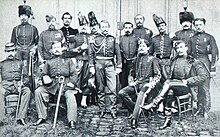French military mission to Japan (1867–1868)



The 1867-1868 French Military Mission to Japan was the first Western military mission to Japan. The mission was formed by Napoléon III, following a request of the Japanese Shogunate in the person of its emissary to Europe, Shibata Takenaka (1823-1877).
Shibata was already negotiating the final details of the French support for the construction of the Yokosuka arsenal, and had additionally requested both the United Kingdom and France to send a military mission for training in Western warfare. The UK apparently denied support to Japan, but the French foreign minister Drouyn de Lhuys (1865-1881) transmitted the agreement of the French government.
The mission consisted of 17 members, under the authority of the Minister of War General Jacques Louis Randon, covering a wide range of expertise: four officers (representing infantry, artillery and cavalry), ten non-commissioned officers and two soldiers. The mission would be headed by staff captain Charles Sulpice Jules Chanoine, at that time an attaché to the military staff of Paris. The members were:

Commander of the mission:
- Captain Charles Sulpice Jules Chanoine
Officers:
- Charles Albert Dubousquet, lieutenant of the 31st Rgt of the Line, infantry instructor.
- Édouard Messelot, lieutenant of the 20th battalion of Chasseurs à Pied, infantry instructor.
- Léon Descharmes, lieutenant of the Empress Dragoon Regiment of the Guard, cavalry instructor.
- Jules Brunet, lieutenant to the Horse Artillery Regiment of the Guard, artillery instructor.
Non-Commissioned Officers:
- Jean Marlin, sergeant to the 8th battalion of Chasseurs à Pied, infantry instructor.
- François Bouffier, sergeant to the 8th battalion of Chasseurs à Pied, infantry instructor.
- Henry Ygrec, sergeant to the 31st Regiment of the Line, infantry instructor.
- Emile Peyrussel, sergeant, sous-maître de manège à l'école d'état-major, cavalry instructor.
- Arthur Fortant, sergeant, Horse Artillery Regiment of the Guard, artillery instructor.
- L. Gutthig, trumpeter to the battalion de Chasseurs of the Guard.
- Charles Bonnet, chef armurier second class.
- Barthélémy Izard, sergeant, chief artificier of the Horse Artillery Regiment of the Guard.
- Frédéric Valette, sergeant, wood specialist.
- Jean-Félix Mermet, brigadier, steel specialist.
- Jourdan, captain, Engineer of the 1st Engineer Regiment.
- Michel, sergeant, Engineer of the 1st Engineer Regiment.
The mission left Marseilles November 19, 1866, and arrived in Yokohama on January 13, 1867. They were welcome on their arrival by Léon Roches and the commander of the French Far East Squadron Admiral Roze.
The military mission was able to train the army of Shogun Tokugawa Yoshinobu for a little more than one year, before the Tokugawa shogunate lost to the Imperial forces in 1868 in the Boshin War. The French military mission was then ordered to leave Japan by Imperial decree in October 1868.
However, Jules Brunet and four of his non-commissioned officers (Fortant, Marlin, Cazeneuve, Bouffier), chose to remain in Japan and continue supporting the Bakufu side. They resigned from the French army, and left for the North of Japan with the remains of the Shogunate's armies in the hope of staging a counter-attack.
The conflict continued until May 1869 until the Battle of Hakodate, with the victory of the Imperial side.
References
- End of the Bakufu and restoration in Hakodate (Japanese: 函館の幕末・維新) ISBN 4-12-001699-4
- French policy in Japan during the closing years of the Tokugawa regime (English), Meron Medzini ISBN 0674322304
- 絹と光、日仏交流の黄金期/ Soie et lumière: l'âge d'or des échanges franco-japonais (French and Japanese), Christian Polak, Hachette Fujingaho ISBN 4573062106
See also
- Second French Military Mission to Japan (1872-1880)
- Third French Military Mission to Japan (1884)
- Fourth French Military Mission to Japan (1918-1919)
